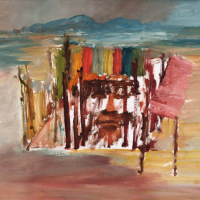38. SIDNEY NOLAN

Sidney Nolan told the writer Colin MacInnes in 1961 that the main ingredients of his iconic 1946-47 Ned Kelly series were Kellys own words, and Rousseau, and sunlight.1 It is an elegant summation and points to Nolans fascination in the Kelly legend which did not diminish from the first series to the last. Parallels between Kellys predicament and Nolans unconventional life and his struggle with celebrity intensified with each successive group of Kelly paintings.
Kelly at Glenrowan 1962, is part of a clutch of works that Sidney Nolan commenced in August 1962. At the time, Nolan was living in London, having recently exhibited in the United States. The main impetus for the new Kelly works was how visual and literary sources and motifs that informed the first and second series from 1946-7 and 1955 could be adapted and re-applied in new and interesting ways. Ned Kelly undergoes a subtle transformation in the 1962 works he is paler, worn and isolated in a dream-like landscape more vulnerable than before. Significantly, the topography and colours mirror Nolans Burke and Wills paintings of the same year.
Nineteenth century photographs formed the basis of Nolans response to the Ned Kelly story. The original photographs (and souvenir postcards that sprung up not long after) depict the Kelly gangs last hours; the kidnapping of local townspeople, the siege at Glenrowan, and the burning of the hotel. The source of many of these photographs was John Bray, a man who had acquired the rights to the photographic negatives from the unknown Oswald Thomas Madeley (c1880). These images were well known to Nolan through his exhaustive reading and research.2
Kelly at Glenrowan is based on a prominent photograph that shows the hotel after it had been burnt to the ground. Surviving upright posts and sheets of twisted corrugated iron are arranged in a similar configuration in Nolans work: he even includes the rectangular Glenrowan Inn sign in the right of the painting. The photograph provides the architectural setting but does not explain the presence of an anguished face that emerges from within the burnt hotel. A second more gruesome photograph could provide a clue it depicts the corpse of one of the bushrangers, charred beyond recognition, being carried away on a sheet of bark on 29 June 1880.
Previous writers have referred to the face in Kelly at Glenrowan but have not mentioned that Nolan depicts it upside down or postulated on potential meanings.3 It is only in comparison with other works from the same year such as Kelly and Kelly Study VI, both 1962, 4 that we realise that the face, now right way up, is a portrait of Ned Kelly and his helmet, with a possible sideway reference to the facial features of Sidney Nolan.
The inverted treatment of figures and heads, as well as the presence of brightly coloured vertical stripes, are visual devices that Nolan used quite frequently in his paintings. What distinguishes the 1962 works from the classic 1946 paintings such as The Chase, Burning at Glenrowan and Siege at Glenrowan (all from the National Gallery of Australia collection) is how Kelly becomes a ghostly apparition in the landscape. He lacks power or agency and is no longer the avenger of injustice as in the Kelly mythology.
Part documentary and part biographical, Nolans Kelly paintings owe a strong debt to European modernism and the naivet of outsider art. They were inspired by the Australian bush and local conditions and used to critique contemporary society. Kelly at Glenrowan and related works show a more reflective, introspective side of the artist. They are rendered in an ethereal style of painting and suggest that Kelly, like Nolan, is neither invincible nor unyielding.
Footnotes
1. Nolan, S., quoted by Andrew Sayers, National Gallery of Australia website
2. Madeley is rarely acknowledged but had been the one foolhardy enough to set up his tripod during the police siege. See Reeder, W., Encyclopedia of nineteenth-century photography, Volume 1. edited by John Hannavy, 2008, p. 101
3. Bonhams, Important Later works from the Estate of Sir Sidney Nolan, 13 October 2014, lot 3
4. Kelly, 1962, oil on hardboard, Leonard Joel, 23 November 2014, lot 320; Kelly Study IV, 1962, Christies, Australian, International & Contemporary Art, Sydney, 26/08/2003, lot 47
Rodney James BA (Hons), MA